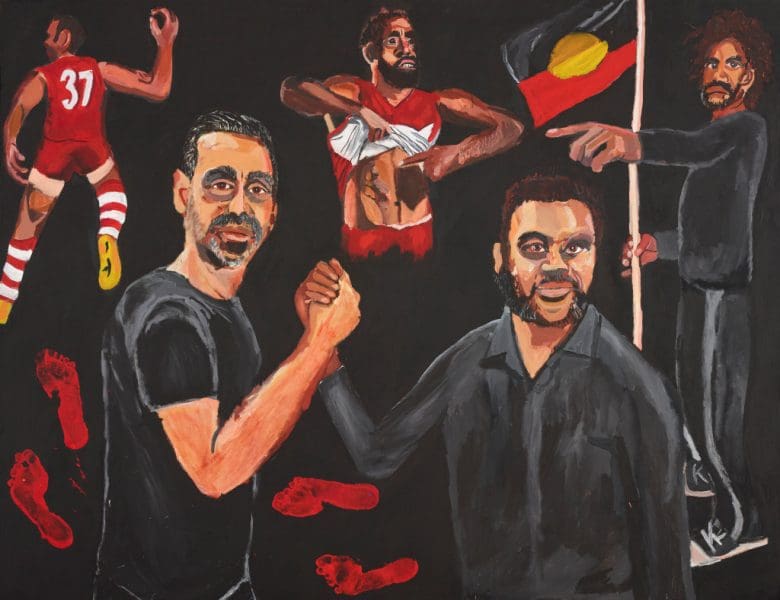
Sophie Penkethman-Young’s Scroll Play
Sophie Penkethman-Young dives into the cursed, chaotic and charming depths of the online world to create inquisitive artworks exploring technology, the internet and capitalism with humour.
When Vincent Namatjira won the 2020 Archibald Prize for portraiture for Stand strong for who you are, his painting of AFL player Adam Goodes, there was a widely held feeling that justice had been done.
Namatjira had entered equally lively pictures in recent years but they had been overlooked for more sedate choices. As the prize has repeatedly shown, it can take some time for the gallery trustee-judges to come around to the work of a hitherto unknown artist, and so when Namatjira took the prize there was a palpable sense of “it’s time.”
Of course the most obvious historic aspect of the award is that Namatjira, from Indulkana, in the Aṉangu Pitjantjatjara Yankunytjatjara region in South Australia (APY lands), is the first Aboriginal artist to win the award.
He is also the great-grandson of Aboriginal painter Albert Namatjira, who was the subject of a 1956 Archibald winning portrait by that stalwart of traditional portrait painting, and eight time winner of the Archibald, Sir William Dargie.

The 2020 award seemed to mark a moment when a number of historical strands came together. Instead of the unfortunately patronising depiction of an Indigenous person by a well-meaning white painter – the standard approach that had been favoured for decades, and had been absurdly pointed to as evidence of inclusion – here for the first time in Archibald history an Aboriginal man was being celebrated for his work.
In a prize that has become inseparable from the politics of the art world, and which tends to focus issues of the day onto the choices of the trustees, there was another element of politics to the selection.
Namatjira’s portrait combined images of himself with his subject, linking his images to well-known media coverage of Goodes’s struggle as an Aboriginal man in a sport, and culture, dominated by both subtle and overt racism.
The Archibald is just one year shy of celebrating its centenary, and the long and storied history of the prize – winners, losers and its attendant controversies – can be seen as a chart of the progress of thinking about art and culture in this country.
It has always been very much a one-step-forward-two-steps-back prize, but when those advances come, they should be savoured.
But as a matter of record it should be noted that not everyone embraced Namatjira’s painting as the rightful winner.
I don’t want to give oxygen to the predictable claims that were made about the choice, but I do want to focus on one aspect of their justification: that is the idea that the artist’s style is demonstrably ‘bad.’
It seems absurd in the 21st century to have to make the case that the things that are broadly considered as hallmarks of artistic ‘quality’ are merely a set of socially accepted ideas about representation, about composition, about likeness, the use of colour and so on.
And although these ideas have been widely questioned for more than 150 years, they have persisted in the broader community because they represent an aspirational ideal about art.
Now, I don’t want to shock you, but there is no fundamental beauty and there is no fundamental truth. The ideas that we commune with are the ones that we derive the most meaning from. For me, those are the ideas that push forward art an inch at a time, the things that make real change, rather than the hand brakes of tradition.
Namatjira’s painting is in fact representative of a vital stream of figurative painting, not just in contemporary art, but in a longer art history that has always valued an authentic expression of idiosyncratic individuality.
The argument that the winning painting ignores or poorly executes a number of traditional components of a ‘successful picture’ are obviously and patently false.
Modernist painting and its post and post-post-modernist descendants represent a broad field of activity that includes any number of approaches to figuration, to the use of colour, and to rethinking approaches to traditional genres like portraiture. Yet Namatjira’s picture does all the things a portrait is supposed to do – and it is socially engaged in a way that very few Archibald finalists truly are.
There is more than ample evidence to support Namatjira’s picture, not as an outsider, but as a work very much within a tradition of portrait painting.
One only need look across his output to also realise that he is a consistent and literate painter with a personal vision that is historically aware, but which is also acutely contemporary in its outlook.
The Archibald Prize is unusual, not just in Australia, but elsewhere too.
Where other traditionalists prizes focused on a particular genre have held firm against progress, and are thus acutely conservative in their outlook, the Archibald has taken baby-step by baby-step into the future, embracing portrait painting as one vital aspect of contemporary art.
While many Archibald finalists and even prize winners seem like contrary examples to this claim, Namatjira’s work will be viewed in the future as historically significant and artistically justified, and naysayers be damned.
Archibald, Wynne and Sulman Prizes 2020
Art Gallery of New South Wales (AGNSW)
26 September – 10 January 2021